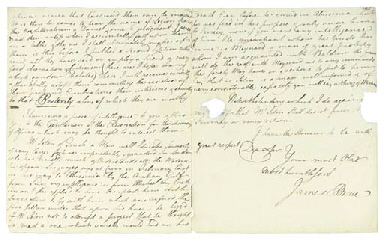JAMES BRUCE (1730-1794)
JAMES BRUCE (1730-1794) Autograph letter signed ('James Bruce') to an unidentified correspondent, probably Joseph Banks, Kinnaird, 12 December 1777, 2 pages, 4to (light wear and browning at edges). Provenance : The Spiro Family collection. A FINE LETTER ON THE NATURAL HISTORY OF EGYPT. Bruce's letter, rich in scientific detail, is likely to have been addressed to Sir Joseph Banks, 'I inclose you a letter to my friend Mr La Trobe who is in possession of the Nubian seeds I wrote you of from Aegypt. I call them Nubian because I found most of them in Abyssinia & Nubia where certainly they never were brought from Aegypt'. Bruce had landed at the port of Abyssinia on 19 September 1769 where he encountered great resistance from the natives. The first European to visit Abyssinia for almost 150 years, he reached the capital in February 1770. Bruce rejects general opinion that Egypt was once under water and therefore could have no indigenous plants, 'I am convinced it never more than Britain was coverd with Sea, & if, as it is certainly true, no plants are found in Aeygpt but what may from their places found be supposed to have been introduced there are scarce any plants can grow in such a climate where being for many months dried to pulverization they are three month entirely coverd with water'. He finds 'the hardiest of all plants are annuals & can only be preserved by planting them in the intervals betwixt those two terrible extremes'. Bruce urges caution in preserving the Arabic names of the seeds which he encloses, 'as from them I may have something to tell you of their history & manner of culture' and continues 'I shall send you the bird by my ship master ... kindest Compts. to Mr Solander. If you please to wrap up the drawing of the Brucia (Wooginous) carefully...'. Solander had been a favourite pupil of Linnaeus, and when Banks first made his acquaintance was employed as an assistant librarian at the British Museum. He subsequently became Banks' companion on his travels around the world and later his librarian. Before becoming President of the Royal Society in 1778, Banks, along with Solander, had accompanied Captain James Cook aboard the Endeavour on his first voyage. Bruce's Travels to Discover the Source of the Nile in the Years 1768-1773 was published in five volumes in 1790. The final volume is titled Select Specimens of Natural History, collected in Travels to discover the Source of the Nile .
JAMES BRUCE (1730-1794)
JAMES BRUCE (1730-1794) Autograph letter signed ('James Bruce') to an unidentified correspondent, probably Joseph Banks, Kinnaird, 12 December 1777, 2 pages, 4to (light wear and browning at edges). Provenance : The Spiro Family collection. A FINE LETTER ON THE NATURAL HISTORY OF EGYPT. Bruce's letter, rich in scientific detail, is likely to have been addressed to Sir Joseph Banks, 'I inclose you a letter to my friend Mr La Trobe who is in possession of the Nubian seeds I wrote you of from Aegypt. I call them Nubian because I found most of them in Abyssinia & Nubia where certainly they never were brought from Aegypt'. Bruce had landed at the port of Abyssinia on 19 September 1769 where he encountered great resistance from the natives. The first European to visit Abyssinia for almost 150 years, he reached the capital in February 1770. Bruce rejects general opinion that Egypt was once under water and therefore could have no indigenous plants, 'I am convinced it never more than Britain was coverd with Sea, & if, as it is certainly true, no plants are found in Aeygpt but what may from their places found be supposed to have been introduced there are scarce any plants can grow in such a climate where being for many months dried to pulverization they are three month entirely coverd with water'. He finds 'the hardiest of all plants are annuals & can only be preserved by planting them in the intervals betwixt those two terrible extremes'. Bruce urges caution in preserving the Arabic names of the seeds which he encloses, 'as from them I may have something to tell you of their history & manner of culture' and continues 'I shall send you the bird by my ship master ... kindest Compts. to Mr Solander. If you please to wrap up the drawing of the Brucia (Wooginous) carefully...'. Solander had been a favourite pupil of Linnaeus, and when Banks first made his acquaintance was employed as an assistant librarian at the British Museum. He subsequently became Banks' companion on his travels around the world and later his librarian. Before becoming President of the Royal Society in 1778, Banks, along with Solander, had accompanied Captain James Cook aboard the Endeavour on his first voyage. Bruce's Travels to Discover the Source of the Nile in the Years 1768-1773 was published in five volumes in 1790. The final volume is titled Select Specimens of Natural History, collected in Travels to discover the Source of the Nile .















Try LotSearch and its premium features for 7 days - without any costs!
Be notified automatically about new items in upcoming auctions.
Create an alert